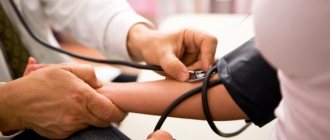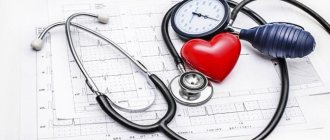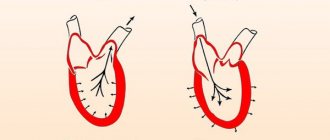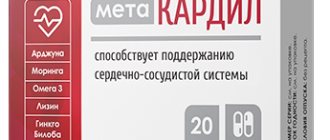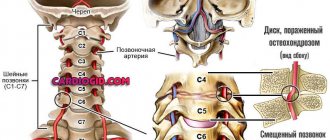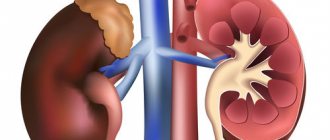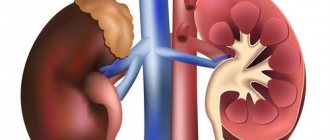Blood pressure is a measure of how much pressure is exerted on the walls of the capillaries as blood moves through them. The condition of the heart, the total volume of blood present in the body, vascular patency and other factors, including a person’s age and weight, can affect blood pressure (blood pressure). If, due to excessive physical activity or after suffering psycho-emotional shocks, blood pressure fluctuates, there is nothing to worry about, but such moments must be kept under control.
But if low diastolic pressure is constantly recorded, you need to take timely measures. Most often, the upper, systolic pressure increases when patients are diagnosed with hypertension, but low diastolic pressure is also not uncommon, and the doctor pronounces a verdict of hypotension. Next, we will discuss the causes of this condition, symptoms and ways to eliminate the problem.
Is it possible to independently raise the lower pressure to normal levels?
It makes sense to try if both indicators: diastolic and systolic are low. Otherwise, it is not recommended to take risks.
The best option would be to adopt a horizontal position, lie quietly, breathe evenly and move less.
The following is the algorithm:
- Take one tonic tablet. Aspirin or Citramon will help.
- Drink a tonic drink, coffee or tea, one cup.
- Eat something salty, such as cucumber.
Contrast showers, baths and the like are not recommended. There will most likely be no consequences, but no effect either.
If there is no increase in indicators within 20 minutes, this is grounds for calling an ambulance.
Doctors will provide the necessary assistance on site and, most likely, will offer hospitalization in a specialized hospital for examination in specialized conditions.
To agree or not is the patient’s choice. If this is not possible, you should make an appointment with a cardiologist and, at the first convenient opportunity, visit a specialist to prescribe a course of treatment.
Stopping an attack is not enough.
What are the main consequences of isolated diastolic hypotension?
Among the adverse consequences of low blood pressure:
- Congestion in the circulatory system. The blood flow is weak, insufficient to nourish tissues and organs. The result is, among other things, the development of chronic heart failure with myocardial atrophy and further weakening of cardiac activity. Everything can end in a heart attack or ischemic stroke.
- Impaired cerebral circulation with the development of secondary encephalopathy. In addition, the risk of such a terrible condition as Alzheimer's disease increases. Or cyanide dementia.
- Heart attack or stroke as a result of insufficient blood circulation in the body. This has already been said.
- Cardiac ischemia.
- Fainting of a sudden nature with possible trauma to the patient in unfavorable conditions. Especially if syncope caught the patient on the street.
It is necessary to be thoroughly examined and undergo a course of specific treatment to ensure that there are no complications. Although it would be more accurate to talk about reducing risks.
The essence and causes of pathology
The arteries are affected by the hormone renin, synthesized by the kidneys. It regulates lower pressure, which is why it is also called renal. The indicator is strictly individual, depending on the age, gender of the patient, and physiological characteristics. The norm up to 50 years allows fluctuations from 60 ± 20 units, after 50 – from 80 ± 10 mm Hg.
- High lower pressure - causes and treatment with drugs and folk remedies
The main reason for the drop in diastolic pressure is the weakening of vascular tone of various origins. At any age, characteristic causes of diastolic hypotension are provoked:
- abuse of alcohol, nicotine, drugs;
- sedentary lifestyle;
- poor nutrition;
- stress, lack of sleep, overwork;
- asthenic neuroses;
- VSD;
- hypothyroidism;
- chronic renal failure;
- infections of any origin;
- sepsis;
- pulmonary embolism;
- pathology of the cardiovascular system;
- avitaminosis;
- Iron-deficiency anemia;
- cervical osteochondrosis;
- taking antidepressants and other medications;
- weather dependence, climate zone change;
- hyperinsolation;
- dehydration;
- intoxication;
- postoperative conditions;
- stuffiness in the room where the patient is;
- sudden change in body position, prolonged bed rest.
Low lower blood pressure can develop against the background of information overload or in athletes as a compensatory reaction to increased physical activity.
In addition, different age groups demonstrate low diastolic pressure, correlating with the causes of hypotension.
| Gender and age | Peculiarities |
| Teenagers | The causes of low diastolic blood pressure in adolescents are often physiological:
The condition normalizes with age. |
| Women under 50 | A common cause is bleeding, both during childbirth and postpartum, as well as menstruation with heavy blood loss. It provokes pathology – varicose veins, taking contraceptives. |
| Women over 50 | In the elderly, the pathology is caused by atherosclerosis with loss of vascular elasticity. Low bottom pressure result:
The danger lies in the development of senile dementia due to constant oxygen starvation of the brain, increasing the risk of stroke and heart attack. |
| Pregnant | Low lower pressure occurs when placental circulation is impaired, there is a lack of nutrition and oxygen for the fetus, which threatens intrauterine death, miscarriage, and the birth of a baby with mental disorders. |
| Men under 50 | The causes of a drop in diastolic blood pressure are:
|
| Men over 50 | In elderly men, diastolic hypotension is associated with age-related atherosclerosis as a result of bad habits, adenoma, prostatitis and chronic renal failure, injuries, toxic poisoning, and Parkinson's disease. |
Physiological factors in the development of hypotension
Isolated arterial diastolic hypotension often develops for pathological reasons. But there is no need to write off natural, physiological ones either.
They are approached first and only then are they looked for for any disease. Physiological factors include:
- Long-term lack of nutrition or insufficient, meager diet. Representatives of the fairer sex with an obsession with losing body weight are especially prone to bad eating habits.
As a result of catabolism, fats are broken down and heat and energy are released. The body spends accumulated resources. When there is no fat left, your own muscle fibers are used.
Hypotension is associated both with the peculiarities of metabolic processes and with a lack of vitamins and organic acids: B12, folic acid, vitamin A, etc.
- Features of genetic material. If there was a relative in the family who suffered from low blood pressure, with a high probability such a feature will manifest itself in the phenotype and genotype of one or more descendants.
Moreover, it is not always the case that if an ancestor’s health was normal due to hypotension, the scenario will be repeated in children or grandchildren. All organisms are different.
- Long periods of physical labor. Hypotension develops especially often in athletes and workers of metallurgical enterprises. Heavy physical activity and difficult environmental conditions lead to the formation of adaptive mechanisms.
Such people can also be recognized by chronic bradycardia (pulse rate less than 60 beats per minute), which usually does not cause them any discomfort.
- Abuse of alcohol and tobacco products. How a particular body will react to the next dose of alcohol or nicotine - no one can say in advance. A common occurrence is hypertension. But this is not the only option.
- Insufficient consumption of table salt. Both an excess of this substance and a lack of sodium chloride salt are bad. We need to look for a balance in consuming “white poison”. Optimally 7 grams per day.
- Peak hormonal conditions, such as puberty, the menstrual cycle and pregnancy in the fairer sex, menopause in men and women.
- Elderly years, provided that the patient moves little or is completely bedridden.
- Acclimatization. For example, when moving to unusual living conditions. Including during the holiday period in warm countries. Easier to adapt to cold weather conditions.
There are many physiological factors. But pathological ones are many times more common. According to specialized studies, the ratio is 70% to 30%.
How to raise lower blood pressure at home
Frequent manifestations of low blood pressure can occur to a person anywhere. Therefore, many people have a question: how to increase lower pressure at home. Before raising diastolic pressure, treating yourself with tablets, without consulting a doctor, is strictly not recommended. You can increase your performance in the following ways:
- Find a comfortable position while lying down (or sitting) and elevate your legs if possible to improve blood circulation.
- Provide adequate access to fresh air.
- Take a contrast shower, which will help speed up the blood circulation process.
- Drink a drink in the form of strong black or green tea. During hot weather, you need to drink enough water to replenish fluid deficiency.
- Do not drink alcohol or strong coffee. A significant amount of caffeine, although capable of raising blood pressure, will increase the heart rate, putting a greater strain on the heart.
Symptoms of low blood pressure
A decrease in blood pressure is not always asymptomatic. Sometimes it is accompanied by unpleasant or painful symptoms that require consultation with a specialist. These include:
- prolonged throbbing headaches;
- dizziness, coordination problems;
- deterioration in sleep quality;
- exhaustion;
- irritability, apathy;
- menstrual dysfunction;
- decreased sex drive;
- blurred vision;
- fainting;
- extraneous noises in the head or ears.
With a sharp drop in indicators to critical levels, a symptom complex very similar to the consequences of a stroke may occur:
- unilateral paresis (face, limbs);
- sensation of goosebumps;
- speech disorders;
- passing blindness (partial or complete).
This condition is considered an emergency. It requires immediate hospitalization of the patient and intensive care.
Low bottom pressure
Blood pressure is divided into two indicators - systolic (upper) and diastolic (lower). The first shows blood pressure during contraction of the heart muscle, and the second - at the moment of its relaxation. When exposed to negative factors, both of these indicators can deviate, both upward and downward.
Sometimes patients complain that only their lower pressure is low, while their upper pressure remains normal. This happens quite rarely. Usually, if blood pressure decreases, both indicators deviate at once. Regardless of whether only the lower pressure has decreased or in combination with the upper one, this indicates disturbances in the body or a short-term jump that occurs due to the influence of external factors.
- How to lower low blood pressure at home: folk remedies and medications
In people constantly exposed to heavy physical activity (athletes), blood pressure of 100/60 or even 90/50 becomes normal
What indicators are we talking about and when can we talk about hypotension?
Diastolic hypotension does not always develop, even if external data suggests it.
Outdated ideas about the norm of 100 to 70 (at the lower limit) are no longer used in medical practice.
New standards from the World Health Organization are being applied, which allows for a reduction in the standard level. Fluctuations in the optimal value are within 10 mmHg.
Therefore, hypotension is considered to be lower pressure, below 60 mmHg (diastolic indicator).
Depending on the individual characteristics of the organism, the following indicators are distinguished:
- Low blood pressure. 60 mm Hg (lower blood pressure level).
- Hypotension of the first degree is below 60 mmHg, but above 50.
- Hypotension of the second or third degree. Below 50 mm.
- Critical hypotension. About 40 mmHg. It poses a danger to life and health. Cardiogenic shock, collapse and death of the patient are possible.
As already mentioned, the indicators are individual in nature and depend on the physiology of a particular person.
But the diastolic indicator should not drop below 60 mmHg. This is no longer normal. If your blood pressure drops, you should immediately consult a doctor.
Treatment
Treatment is prescribed only after identifying the underlying cause of the disease. If low lower blood pressure is just one of the symptoms of the underlying disease, then therapy is prescribed for the underlying pathology and the pressure is corrected during therapy.
There are also general provisions for a hypotensive patient. Firstly, this is a lifestyle correction. This concept includes several aspects:
- Normalization of sleep and rest patterns. People with low blood pressure need more sleep to feel full and productive. It is even recommended to set aside time for naps during the day.
- Nutrition correction. A balanced diet and adequate water load will provide a full range of all substances necessary for good heart function, normal circulating blood volume and good vascular condition.
- Physical activity. The main cause of lower hypotension depends primarily on the tone of the vascular wall. Dynamic exercises will help normalize tone: walking, jogging, active team games, cycling, swimming. Do not forget that you should not overload the body. Loads must be increased gradually, preferably under the supervision of a trainer familiar with the basics of physical therapy. It is necessary to take into account the presence of contraindications.
- Hardening. A method of traditional folk medicine, which is also aimed at normalizing vascular tone. It should be introduced gradually. It's best to start with a contrast shower. In this case, the water temperature should initially differ by 2-3˚C, and then gradually increase the difference in degrees. Of course, contraindications must also be taken into account.
- Be in the fresh air more often, take more walks, go to the forest, park area, away from polluted city air. Hypotonic patients are recommended to sleep with an open window to correct their chronic hypoxia.
- Normalization of the emotional background. Avoid stressful and conflict situations.
Secondly, there is also an auxiliary drug correction based on herbal preparations: Eleutherococcus, Ginseng, Schisandra. Such generally accepted methods of correcting hypotension as drinks with high caffeine content, alcohol and chocolate are not recommended by official medicine.
How to treat isolated diastolic hypotension?
Lower blood pressure can only be increased by eliminating the root cause of the pathological condition using drug therapy.
The list of drugs is selected by a medical specialist. Tonics are also used, but in strictly controlled dosages.
In extreme cases, they resort to surgery on the heart and blood vessels. This is a relatively rare measure, especially in young patients (not counting cases with organ defects).
It is important to change your lifestyle: move more, but do it right, eat normally, avoid stress, give up bad habits. The doctor gives specific recommendations based on the situation.
Drug treatment alone is not enough. A complex effect on the body is required. It will take effort on the part of the patient himself.
Proper nutrition
The importance of diet in cardiovascular diseases cannot be underestimated. Food must fulfill its functions of providing energy and have a tonic taste effect on a person. A small amount of strong green tea or coffee in the morning will be helpful.
You can indulge in salty foods. Sodium chloride slightly increases the elasticity of the vascular wall. It is worth using seasonings and spices. They have a general tonic effect.
Food for hypotension should be high in fiber and vitamins. Dietary fiber masses promote intestinal motility, prevent constipation, and reduce cholesterol levels. Vitamins allow an elderly person to lead an active lifestyle and reduce the risk of ischemic conditions.
Forecast
Low blood pressure will not cause additional health problems. However, it can increase the risk of falls, which is especially dangerous for older people. People with low diastolic blood pressure may also have an increased risk of developing heart failure. Symptoms of heart failure include:
- shortness of breath
- persistent cough
- swelling in the lower body
- weakness
- nausea
- confusion
Researchers found a significant increase in the risk of heart damage in people over 60 years of age who had low diastolic blood pressure.
Changes in diet and exercise can help improve low diastolic blood pressure.
Related Research Article: Research suggests low blood pressure may be a cause of dementia.
conclusions
Hypertension is a leading cause of cardiovascular mortality and morbidity, but clinical BP measurements alone underestimate its prevalence in healthy individuals considered normotensive at these levels (66). We argue that CST BP measurements serve as a complementary assessment for clinical and outpatient assessment of hypertension and CVD risk, diagnosis, and prognosis. However, this approach is still hampered by the unreasonableness of previously proposed values and the lack of empirical diagnostic indicators of BP. To facilitate accurate classification of normal and excessive BP responses, existing guidelines need to be reinterpreted. Clinically significant abnormalities in BP response should be defined in terms of the rate of change in BP relative to workload or cardiac output in addition to peak values obtained during exercise. It is important to note the modulating influence of age, gender, level of training, health status and medications taken, which may be a consequence of an adaptive state (higher level of training), and not a connection with pathology. Finally, without positive clinical results, there is no need to stop CNT at high blood pressure thresholds, since there is no scientific evidence that such a reaction is associated with adverse events.
Source:
https://link.springer.com/



